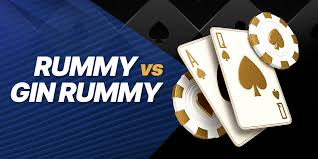Rummy vs Gin Rummy Rules, are both popular card games that belong to the same family but have distinct rules and gameplay. While they share similarities in terms of forming sets and runs, they differ in how the game is played, scored, and won. This article explores the differences between Rummy and Gin Rummy, providing a clear understanding of each game’s rules and strategic elements.
Basic Objective
Both Rummy and Gin Rummy have the same primary objective: to form sets and runs with your cards. A set consists of three or four cards of the same rank but different suits (e.g., 7♦, 7♠, 7♣), while a run consists of three or more consecutive cards of the same suit (e.g., 4♥, 5♥, 6♥).
Rummy Rules
1. Deck and Players:
- Rummy is typically played with a standard 52-card deck.
- The game can accommodate 2 to 6 players.
2. Dealing:
- Each player is dealt 10 cards if there are 2 to 4 players, or 7 cards if there are 5 or more players.
- The remaining cards form the draw pile, with the top card placed face-up to start the discard pile.
3. Gameplay:
- Players take turns drawing one card from either the draw pile or the discard pile.
- After drawing, players can lay down any valid melds (sets or runs).
- At the end of their turn, players must discard one card to the discard pile.
- The round ends when a player has formed all their cards into valid melds and discards their final card.
4. Scoring:
- Points are calculated based on the remaining deadwood (unmelded cards) in each player’s hand.
- Face cards (K, Q, J) are worth 10 points each, aces are worth 1 point, and number cards are worth their face value.
- The player who goes out scores the difference between their deadwood points and their opponents’ deadwood points.
5. Winning the Game:
- The game can be played over multiple rounds, with the first player to reach a predetermined score (e.g., 100 or 500 points) declared the winner.
Gin Rummy Rules
1. Deck and Players:
- Gin Rummy uses a standard 52-card deck.
- It is typically played by 2 players, but variations for 3 or 4 players exist.
2. Dealing:
- Each player is dealt 10 cards.
- The remaining cards form the draw pile, with the top card placed face-up to start the discard pile.
3. Gameplay:
- Players take turns drawing one card from either the draw pile or the discard pile.
- After drawing, players can lay down any valid melds (sets or runs).
- At the end of their turn, players must discard one card to the discard pile.
- A player can “knock” if their deadwood points are 10 or fewer, ending the round.
- Alternatively, a player can go for “Gin” by forming all their cards into melds with no deadwood.
4. Scoring:
- If a player knocks, both players reveal their hands, and deadwood points are calculated.
- The knocker scores the difference between their deadwood points and their opponent’s deadwood points.
- If the opponent has fewer or equal deadwood points, they score the difference plus a 25-point bonus (undercut).
- Going Gin earns a 25-point bonus plus the opponent’s deadwood points.
5. Winning the Game:
- Gin Rummy is typically played in multiple rounds, with the game continuing until one player reaches 100 points.
- Additional bonuses are awarded at the end of the game, such as a 100-point game bonus for the winner and a 25-point bonus for each hand won.
Key Differences
1. Number of Players:
- Rummy can be played with 2 to 6 players, while Gin Rummy is usually played with 2 players.
2. Knocking:
- Knocking is a unique feature in Gin Rummy, allowing a player to end the round when their deadwood points are 10 or fewer. There is no equivalent in standard Rummy.
3. Scoring:
- Gin Rummy has more complex scoring with bonuses for knocking, going Gin, and undercutting. Rummy scoring is simpler, focusing on deadwood points.
4. Strategy:
- Gin Rummy involves more strategic decision-making around when to knock and manage deadwood. Standard Rummy focuses more on forming melds and minimizing deadwood.
Conclusion
Rummy and Gin Rummy, while sharing the same foundational goal of forming sets and runs, offer different gameplay experiences due to their unique rules and strategies. Rummy’s flexibility with player numbers and straightforward play makes it a versatile choice for group settings. Gin Rummy, with its strategic knocking and complex scoring, provides a more intense head-to-head challenge. Understanding the nuances of each game can enhance your enjoyment and mastery of these classic card games. Whether you prefer the simplicity of Rummy or the strategic depth of Gin Rummy, both games offer hours of engaging and competitive fun.




